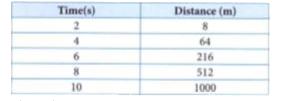(a)State and explain Newton's second law of motion.
(b) A 1000 kg vehicle moving with a speed of 20 m/s is brought to rest in a distance of 50 metres:
(i) Find the acceleration.
(ii) Calculate the unbalanced force acting on the vehicle.
The correct Answer is:(b) (i) -4 m/s2 (ii) -4000 N 37.
Step-by-Step Solution
Topper's Solved these Questions
Similar Questions
A bullet of mass 50g moving with a speed of 500ms−1 is brought to rest in 0.01s Find the impulse and the average force .
View SolutionThe total mass of an elevator with a 80 kg man in it is 1000 kg. This elevator moving upward with a speed of 8 m/sec, is brought to rest over a distance of 16m. The tension T in the cables supporting the elevator and the force exerted on the man by the elevator floor will respectively be-
View Solution
Knowledge Check
A 810 kg car accelerates from rest to 27 m/s in a distance of 120 m. What is the magnitude of the average net force acting on the car ?
A740 NB2500 NC91 ND1300 NA body of mass m kg starts from rest and travels a distance of s m in t seconds. The force acting on it is
A2mst2NBmstNCms22tNDms2tNA car is moving on a circular road of diameter 50 m with a speed of 5 m/s. It is suddenly accelerated at a rate of 1m/s2. If the mass of he car is 500 kg, then the net force acting on the car is
A5 NB1000 NC500√2ND500√2
A body of mass 2kg moving with a velocity of 10m/s is brought to rest in 5sec. Calculate the stopping force applied.
View SolutionA cricket ball of mass 0.2 kg moves with a velocity of 20 m/s and is brought to rest by a player in 0.1 s. Calculate the impulse of the ball and average force applied by the player.
View SolutionA motor car of mass 20 quintal moving with velocity of 60 kmh−1, by the application of brakes, is brought to rest in a distance of 3 km. Find the average force of resistance in newton.
View SolutionA hammer of mass 1 kg moving with speed of 6ms−1 strikes a wall and comes to rest in 0.1 s . Calculate (i) the impules of force (ii) the retardation of the hammer , and (iii) the retarding force that stops the hammer .
View SolutionWhen a body is moving uniformly along a straight line and there is no force of friction, acceleration/retardation of the body. According to Newton's second law of motion, the magnitude of force acting on a body is the product of mass and acceleration of the body
The distance - time table of an object in motion is given below

The force acting on the object
View Solution
